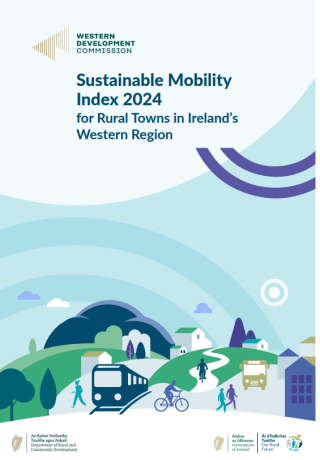Sustainable Mobility Index 2024 for Rural Towns in Ireland’s Western Region

The Western Development Commission (WDC) has released the Sustainable Mobility Index 2024, offering an in-depth evaluation of transport progress across 40 rural towns across Ireland's Western Region. This comprehensive assessment highlights significant advancements in public transport accessibility and connectivity, while also pinpointing areas requiring further investment, particularly in active travel infrastructure, affordability, and connectivity.
The Index aims to enhance understanding of active modes and public transport within a rural context, aligning with the shift in transport policy towards more sustainable travel options and the necessity of reducing carbon emissions from personal transport. The index comprises 30 indicators across three key themes
-
Readiness for the Low-Carbon Transition: Evaluates infrastructure and initiatives supporting a shift to low-carbon transport modes.
-
Access to Services and Social Facilities: Assesses the availability and convenience of transport options connecting residents to essential services and social amenities.
-
Access to Employment and Economic Opportunities: Measures the effectiveness of transport links facilitating access to workplaces and economic hubs.
Key Findings
The Index reveals a wide range of mobility scores among the assessed towns, indicating varying levels of progress and infrastructure development. Notably, Westport has climbed three places to secure the No.1 ranking, reflecting the benefits of ongoing investment in sustainable transport. Claremorris and Ballyhaunis have also shown significant improvements, now ranking in the top 12, with Ballyhaunis experiencing the greatest improvement of all 40 towns, rising 14 places.
In County Donegal, towns such as Bundoran, Ballybofey-Stranorlar, Ballyshannon, Buncrana, Carndonagh, Convoy, Donegal Town, and Lifford have demonstrated progress in sustainable transport, with Bundoran leading the county in overall performance at 13th nationally.
Policy Proposals
The average distance to most everyday services for people in rural areas is at least three times longer than for people in urban areas. For supermarkets, GPs and pharmacies, the average travel distance was seven times longer for rural dwellings. This raises challenges for delivery of services as our population grows and ages. Rural areas generally have an older population, higher rates of part-time employment, lower median incomes, higher dependency ratios and higher poverty rates than the national average. High quality and connected public transport links are vital to the future of rural economies.
Government policy must support and invest in thriving communities all across the country, but especially in rural areas. This requires leadership and commitment on the policies required to move to a low carbon future, and also requires investment in services and infrastructure that are capable of adapting to the changing needs of the population and climate over time.
